How to render in 4k in blender dimensions
With the advancement of display technology, 4K resolution has become the new standard. Whether you're creating animations, visual effects, or virtual environments, high-quality 4K rendering can significantly enhance the detail and depth of your work. This guide will walk you through setting up and optimizing 4K rendering in Blender, covering resolution settings, material optimization, lighting adjustments, and final output steps.
Setting 4K Resolution
The key to rendering in 4K resolution in Blender is correctly configuring the resolution parameters. Start by navigating to the "Output Properties" panel in Blender. Under the "Resolution" section, set the width to 3840 pixels and the height to 2160 pixels, which corresponds to the 4K UHD standard. If you require an even higher resolution, you can adjust these values accordingly.

To ensure that each frame is rendered at the highest quality, set the percentage value (%) to 100%. This parameter controls the final render resolution. While it's common to lower this percentage to 50% or 75% for quicker previews during testing, be sure to set it to 100% for the final render.
Optimizing Materials and Textures
At high resolution, detail representation is critical. To fully utilize the benefits of 4K resolution, apply high-quality materials and textures to every object in your scene. Low-resolution textures will appear blurry and detract from the overall effect in a 4K render. Therefore, always use high-resolution texture maps and ensure they are appropriately scaled to the objects they are applied to.
For key objects such as characters, buildings, or important props, consider using normal maps and displacement maps to enhance detail. This will ensure that even at 4K resolution, the surfaces of objects exhibit rich, detailed textures.
If you need high-quality 3D textures and HDRIs for your models and virtual scenes, you can download them for free from [Relebook](https://textures.relebook.com) to ensure your work remains sharp and clear at 4K resolution. Additionally, if you require premium 3D models, you can download them from [Relebook](https://3dmodels.relebook.com), where you'll find a vast array of top-quality 3D resources.

Importance of Lighting Setup
Lighting is a crucial factor in any rendering process, especially at 4K resolution, where light and shadow are rendered with even greater precision. Properly setting up light sources and environmental lighting will add depth and realism to your scene.
In Blender, you can use HDRI images to achieve complex and realistic lighting effects. HDRI not only provides even lighting across the scene but also simulates natural reflections and shadows. To enhance the contrast and visibility of light and shadow effects, consider adding additional light sources or adjusting the intensity and direction of the main light.
Additionally, enabling Blender's Global Illumination and Ambient Occlusion options will further enhance the depth of the scene, making it appear more three-dimensional and realistic in 4K resolution.
Render Settings and Performance Optimization
Rendering in 4K requires more powerful computing resources, making optimization of render settings crucial. In Blender, you can adjust the sample count to balance render quality and time. The higher the sample count, the better the image quality, but this also increases render time. For 4K rendering, it's recommended to use a higher sample count to reduce noise and ensure the image is crisp.
Also, properly configuring the Anti-Aliasing settings will smooth out the edges, preventing jagged lines. You can further speed up rendering by utilizing Blender’s Distributed Rendering feature, which distributes rendering tasks across multiple computing nodes.
Output and Post-Processing
Once rendering is complete, exporting a high-quality 4K image or video is the final step. For image outputs, it's recommended to use the PNG or EXR format, and for videos, use a high-bitrate encoder to ensure that no details are lost during post-production.
After rendering, Blender’s built-in compositor can be used for post-processing tasks like color correction, sharpening, or adding special effects. The increased detail available at 4K resolution makes these adjustments more flexible, allowing for precise control over every pixel.
Rendering in 4K resolution in Blender is a demanding task that requires careful attention at every stage of the process. From resolution settings and material optimization to lighting adjustments and final output, each step contributes to the overall render quality. With the right settings and optimizations, you can produce richly detailed and visually stunning 4K renders that add significant visual impact to your projects. If you need high-quality 3D textures and HDRIs for your models and virtual scenes, you can download them for free from [Relebook](https://textures.relebook.com). If you require premium 3D models, you can find them at [Relebook](https://3dmodels.relebook.com), where a wide selection of top-tier 3D resources is available.

